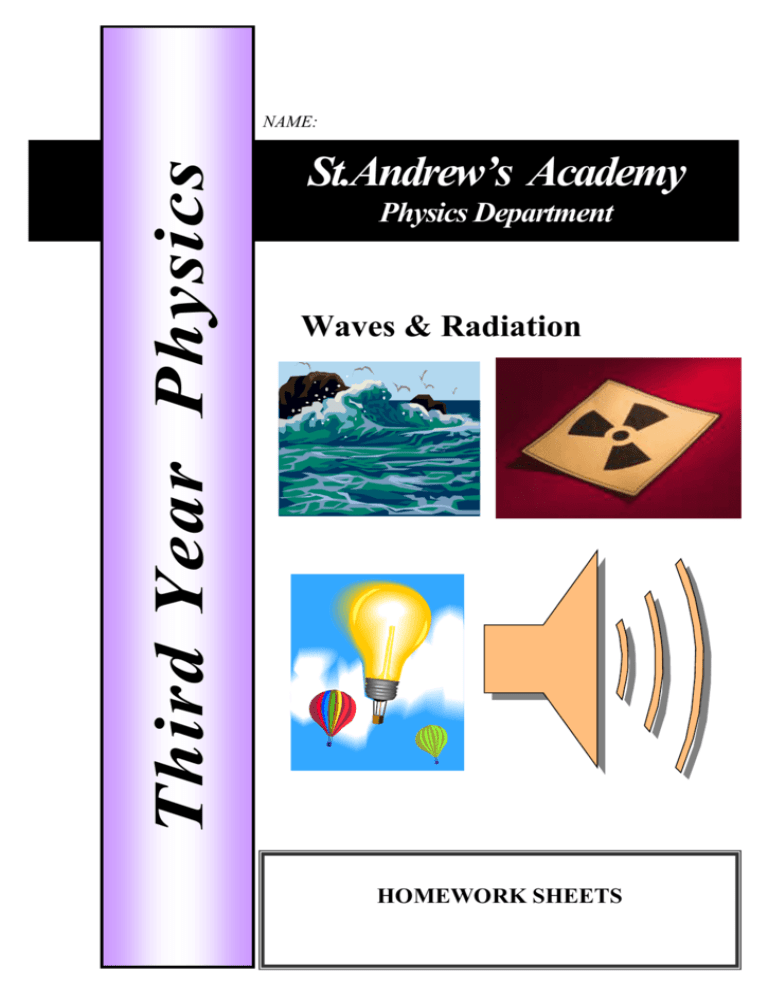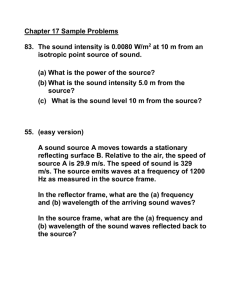Waves and Radiation 1
advertisement

Third Year Physics NAME: St.Andrew’s Academy Physics Department Waves & Radiation HOMEWORK SHEETS Waves and Radiation 1 1. What is meant by a transverse wave (1) 2. What is meant by a longitudinal wave (1) 3. Give an example of (a) A transverse wave (b) A longitudinal wave (2) 4. Copy and complete the following statement. Waves transmit________________ from one place to another (1) 5. The diagram below shows a diagram of a transverse wave moving from left to right. The distance from A to B is 12m 12m 4m (a) (b) (c) (d) (e) A B How many complete waves are there between A and B What is the wavelength of the waves What is the amplitude of the waves Will a particle at point A move up and down or from left to right The wave is now given more energy with no change in frequency. What happens to the (i) The amplitude (ii) The wavelength (6) 6. What is meant by the frequency of a wave? (1) 7. What are the units of frequency (1) 8. 200 waves pass a point in 10seconds. Calculate the frequency of the waves (2) 9. 600 waves pass a point in 5minutes. Calculate the frequency (2) 10. The frequency of a wave is 50Hz. How many waves pass a point in 5seconds (2) Waves and Radiation 2 1. A wave of frequency 8Hz has a speed of 16ms-1. Calculate its wavelength (2) 2. The questions below refer to this diagram. 10m 2m (a) (b) (c) (d) A B How many waves are there between A and B Calculate the wavelength of the waves If the speed of the waves is 4ms-1 calculate the frequency What is the amplitude of the waves (6) 3. A train of waves leaves point A and travels a distance of 60m to point B in 12seconds. Claire at point B counts the number of waves passing B and counts 20 waves in 5 seconds 60m A (a) (b) (c) Calculate the speed of the waves Calculate the frequency of the waves Hence calculate the wavelength B (6) 4. Radio Scotland broadcasts an AM signal on 810 kHz and an FM signal on 94.3 MHz. (a) What is the speed of radio waves (b) Calculate the wavelength of the AM signal (c) Calculate the wavelength of the FM signal (d) State and explain which signal is unlikely to be received if you live in an area surrounded by hills (e) A passenger in a car listens to the radio. When the car enters a tunnel the sound from the radio fades. Explain this observation (8) Waves and Radiation 1. 3 Ten pupils are standing on Calton Hill, looking at Edinburgh Castle. They measure the time difference between seeing the smoke from the one o’clock gun and hearing the bang. Their measured times were 3.8 s, 4.2 s, 4.0 s, 3.8 s, 4.4 s, 3.8 s, 4.0 s, 4.2 s, 3.6 s and 4.2 s. (a) Calculate the average time for the group. (b) Calculate the distance from the Castle to Calton Hill, if the speed of sound is 340 m/s (3) 2. A person at the mouth of a cave shouts, and hears an echo from the back wall of the cave. Using a stopwatch, she times 1 second between shouting and hearing the echo. Calculate how far away she is from the back wall of the cave. Take the speed of sound to be 340 m/s. (3) 3. Give two examples of noise pollution. 4. Answer the following questions in your jotter. (a) What is sound produced by? (b) What do we call sound frequencies greater than 20 000 Hz? (2) (2) 5. What is the definition of frequency? (1) 6. How long will it take a sound wave to travel a distance of 6000 km? (2) 7. How long will it take light from the sun to reach the earth, a distance of 1.5 x1011m (2) 8. How far will light travel through air in 0.25s. 9. It takes light 0.006s to travel through an optical fibre of length 1200km. Calculate the speed of light in the optical fibre (2) (2) Waves and Radiation 4 1. A pupil reads about an experiment that can be carried out to measure the speed of sound in air. When the hammer hits the metal block a sound wave is produced. The computer is used to measure the time it takes for the sound wave to travel from one microphone to the other. The computer will display the time taken for the sound to travel this distance or it can be used to calculate the speed of sound directly. interface second microphone first microphone computer hammer 2.00 m The pupil carried out the experiment, and the time measured was 0.006 s. (a) What other information must be fed into the computer in order for it to work out the speed of sound for her? (b) Find the speed of sound using the pupil's results. (3) 2. You see a flash of lightning and then hear the thunder 6 seconds later. (a) Explain why you see the lightning before you hear the thunder (b) Calculate the distance to the thunderstorm (3) 3. An explosion in Glasgow could be heard in Erskine a minute later, a distance of 20km away. Calculate the speed of sound from this data. (2) 4. At an athletics meeting David and Jane stand at the finishing line with stopwatches to check the winning time for the sprint. David Jane Start 80m Finish The starter who is 80m away fires the gun. David starts his watch as soon as he sees the flash. Jane starts her watch when she hears the bang. David records a winning time of 11s. (a) Calculate the time taken for the sound to travel to Jane (b) What time would Jane record (c) Explain who is most likely to be correct (4) Waves and Radiation 5 1. What causes sound (1) 2. Copy and complete the following statement. Sound can pass through _____________, __________ and ___________ but cannot pass through a ______________ (1) 3. What is meant by ultrasounds (1) 4. Give one use of ultrasounds in medicine (1) 5. Look at the diagram of a sound signal displayed on an oscilloscope Copy the signal and below it draw a signal (a) Which has a louder sound of the same frequency (b) Which has a note of higher frequency but same loudness (2) 6. The depth of the sea can be measured using sound waves The ultrasound waves are transmitted from the ship and the waves reflected from the seabed and picked up by a receiver on the ship. The frequency of the transmitted waves is 30kHz One pulse is received 0.02s after it has been sent out. The speed of sound in water is 1500ms-1 (a) Calculate the depth of the seabed (b) Calculate the wavelength of the sound in water (5) 7. Give the unit of sound level (1) 8. Give a common example of noise pollution in (a) Your home (b) town centre (2) Waves and Radiation 6 1. (a) In what way could a noisy factory cause harm to its workers? (b) How could the workers avoid this harm? (without quitting their jobs!) (2) (2) 2. Give two examples of where ultrasound is used. 3. Copy the table below, and fill in the blanks to give information about short & long sight: EYE DEFECT Short sight Long sight DESCRIPTION LENS USED (2) 4. Copy and complete the diagrams below to show how the light travels through the blocks. (6) 5. Copy and complete the eye diagram to show how the eye of a short-sighted person would focus the rays of light. 6. A ray of light passes from air to glass as shown: air (1) glass (5) (a) Copy and complete this diagram to show what happens to the ray in the glass. (b) What is this effect called? (c) Add the normal to the diagram, and label the angle of incidence and angle of refraction. Waves and Radiation 7 Read the passage below and use it to answer the questions that follow. The sun is a star 150 x106 km from Earth which produces enormous amounts of energy in the form of electromagnetic waves. We can detect the visible light from the sun with our eyes but we cannot detect the invisible ultraviolet light which also reaches Earth. Exposure to the ultraviolet light from the sun can produce a change in the colouring of the skin which we call a sun tan. There are three types of ultraviolet radiation. We are constantly exposed to UVA and we need this for healthy growth and to make vitamin D in our bodies. UVA light has wavelengths in the range 315 to 400 nm. UVB light has wavelengths in the range 280 to 315 nm. Most of the UVB light from the sun is removed by the layer of ozone in the atmosphere around the Earth. Scientists have found that there is a hole in the ozone layer which is allowing more UVB to reach us on the surface of the earth. UVB can cause a skin cancer called melanoma. The third type of UV light, with wavelengths in the range 200 to 280 nm, is called UVC . People who are going to be exposed to the sun for any length of time should protect their skin with sun tan cream. An extract from the back of a bottle of sun tan cream is given below. Bronzage cream protects the skin from sun burn, premature skin ageing and long term damage to the internal structure of the skin by filtering out the harmful UVA/UVB rays from sunlight. Bronzage is water resistant even after a swim of 30 minutes. 1. Calculate how long it takes for ultraviolet light to travel from the sun to Earth. (2) 2. Construct a table giving the wavelengths of UVA, UVB and UVC light. (3) 3. Calculate the frequency of the shortest wavelength UVC light. (3) 4. What type of UV light has a frequency of 7·5 x 1014 Hz? (3) 5. What range of wavelengths does Bronzage sun tan cream block? (2)







